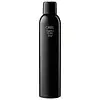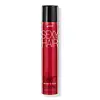What's inside
What's inside
 Benefits
Benefits

 Concerns
Concerns

 Ingredients Side-by-side
Ingredients Side-by-side

Sd Alcohol 40-B
AstringentDimethyl Ether
SolventOctylacrylamide/Acrylates/Butylaminoethyl Methacrylate Copolymer
Aminomethyl Propanol
BufferingParfum
MaskingGlycerin
HumectantAcetyl Triethyl Citrate
MaskingPEG/PPG-17/18 Dimethicone
EmulsifyingWater
Skin ConditioningPanthenol
Skin ConditioningAmp-Isostearoyl Hydrolyzed Wheat Protein
CleansingBenzophenone-4
UV AbsorberCitrullus Lanatus Seed Oil
EmollientActinidia Chinensis Fruit Extract
EmollientAloe Barbadensis Leaf Extract
EmollientHedychium Coronarium Root Extract
MaskingMangifera Indica Fruit Extract
Skin ConditioningLitchi Chinensis Fruit Extract
Skin ConditioningPhenoxyethanol
PreservativeLeontopodium Alpinum Flower/Leaf Extract
Skin ConditioningStyrax Benzoin Resin Extract
MaskingCitric Acid
BufferingPotassium Sorbate
PreservativeSodium Benzoate
MaskingLimonene
PerfumingHexyl Cinnamal
PerfumingLinalool
PerfumingCitral
PerfumingSd Alcohol 40-B, Dimethyl Ether, Octylacrylamide/Acrylates/Butylaminoethyl Methacrylate Copolymer, Aminomethyl Propanol, Parfum, Glycerin, Acetyl Triethyl Citrate, PEG/PPG-17/18 Dimethicone, Water, Panthenol, Amp-Isostearoyl Hydrolyzed Wheat Protein, Benzophenone-4, Citrullus Lanatus Seed Oil, Actinidia Chinensis Fruit Extract, Aloe Barbadensis Leaf Extract, Hedychium Coronarium Root Extract, Mangifera Indica Fruit Extract, Litchi Chinensis Fruit Extract, Phenoxyethanol, Leontopodium Alpinum Flower/Leaf Extract, Styrax Benzoin Resin Extract, Citric Acid, Potassium Sorbate, Sodium Benzoate, Limonene, Hexyl Cinnamal, Linalool, Citral
Alcohol Denat.
AntimicrobialHydrofluorocarbon 152a
Octylacrylamide/Acrylates/Butylaminoethyl Methacrylate Copolymer
Aminomethyl Propanol
BufferingPEG/PPG-17/18 Dimethicone
EmulsifyingParfum
MaskingTriethyl Citrate
MaskingPhenyl Trimethicone
Skin ConditioningPentaerythrityl Tetracaprylate/Tetracaprate
EmollientAmp-Isostearoyl Hydrolyzed Wheat Protein
CleansingEthylhexyl Methoxycinnamate
UV AbsorberWater
Skin ConditioningHydrolyzed Vegetable Protein Pg-Propyl Silanetriol
Skin ConditioningKeratin Amino Acids
Skin ConditioningPolysorbate 80
EmulsifyingPanthenol
Skin ConditioningCarpotroche Brasiliensis Seed Oil
Skin ProtectingQuaternium-52
Benzyl Salicylate
PerfumingLimonene
PerfumingHexyl Cinnamal
PerfumingLinalool
PerfumingAlcohol Denat., Hydrofluorocarbon 152a, Octylacrylamide/Acrylates/Butylaminoethyl Methacrylate Copolymer, Aminomethyl Propanol, PEG/PPG-17/18 Dimethicone, Parfum, Triethyl Citrate, Phenyl Trimethicone, Pentaerythrityl Tetracaprylate/Tetracaprate, Amp-Isostearoyl Hydrolyzed Wheat Protein, Ethylhexyl Methoxycinnamate, Water, Hydrolyzed Vegetable Protein Pg-Propyl Silanetriol, Keratin Amino Acids, Polysorbate 80, Panthenol, Carpotroche Brasiliensis Seed Oil, Quaternium-52, Benzyl Salicylate, Limonene, Hexyl Cinnamal, Linalool
Ingredients Explained
These ingredients are found in both products.
Ingredients higher up in an ingredient list are typically present in a larger amount.
Aminomethyl Propanol is used to adjust the pH of products. It is also used as a base to create other organic compounds. Having a balanced pH is important for protecting your skin.
Aminomethyl propanol is safe to use in cosmetics up to 1%. It is soluble in water.
We don't have a description for Amp-Isostearoyl Hydrolyzed Wheat Protein yet.
Hexyl Cinnamal is a fragrance ingredient with a similar scent to jasmine. It can be naturally found in chamomile essential oil.
This ingredient is a known EU allergen and may sensitize the skin. The EU requires this ingredient to be listed separately on an ingredients list.
Hexyl Cinnamal is not water soluble but is soluble in oils.
Learn more about Hexyl CinnamalLimonene is a fragrance that adds scent and taste to a formulation.
It's found in the peel oil of citrus fruits and other plants such as lavender and eucalyptus. The scent of limonene is generally described as "sweet citrus".
Limonene acts as an antioxidant, meaning it helps neutralize free radicals.
When exposed to air, oxidized limonene may sensitize the skin. Because of this, limonene is often avoided by people with sensitive skin.
The term 'fragrance' is not regulated in many countries. In many cases, it is up to the brand to define this term. For instance, many brands choose to label themselves as "fragrance-free" because they are not using synthetic fragrances. However, their products may still contain ingredients such as essential oils that are considered a fragrance.
Learn more about LimoneneLinalool is a fragrance and helps add scent to products. It's derived from common plants such as cinnamon, mint, citrus, and lavender.
Like Limonene, this ingredient oxidizes when exposed to air. Oxidized linalool can cause allergies and skin sensitivity.
This ingredient has a scent that is floral, spicy tropical, and citrus-like.
Learn more about LinaloolWe don't have a description for Octylacrylamide/Acrylates/Butylaminoethyl Methacrylate Copolymer yet.
Panthenol is a common ingredient that helps hydrate and soothe the skin. It is found naturally in our skin and hair.
There are two forms of panthenol: D and L.
D-panthenol is also known as dexpanthenol. Most cosmetics use dexpanthenol or a mixture of D and L-panthenol.
Panthenol is famous due to its ability to go deeper into the skin's layers. Using this ingredient has numerous pros (and no cons):
Like hyaluronic acid, panthenol is a humectant. Humectants are able to bind and hold large amounts of water to keep skin hydrated.
This ingredient works well for wound healing. It works by increasing tissue in the wound and helps close open wounds.
Once oxidized, panthenol converts to pantothenic acid. Panthothenic acid is found in all living cells.
This ingredient is also referred to as pro-vitamin B5.
Learn more about PanthenolParfum is a catch-all term for an ingredient or more that is used to give a scent to products.
Also called "fragrance", this ingredient can be a blend of hundreds of chemicals or plant oils. This means every product with "fragrance" or "parfum" in the ingredients list is a different mixture.
For instance, Habanolide is a proprietary trade name for a specific aroma chemical. When used as a fragrance ingredient in cosmetics, most aroma chemicals fall under the broad labeling category of “FRAGRANCE” or “PARFUM” according to EU and US regulations.
The term 'parfum' or 'fragrance' is not regulated in many countries. In many cases, it is up to the brand to define this term.
For instance, many brands choose to label themselves as "fragrance-free" because they are not using synthetic fragrances. However, their products may still contain ingredients such as essential oils that are considered a fragrance by INCI standards.
One example is Calendula flower extract. Calendula is an essential oil that still imparts a scent or 'fragrance'.
Depending on the blend, the ingredients in the mixture can cause allergies and sensitivities on the skin. Some ingredients that are known EU allergens include linalool and citronellol.
Parfum can also be used to mask or cover an unpleasant scent.
The bottom line is: not all fragrances/parfum/ingredients are created equally. If you are worried about fragrances, we recommend taking a closer look at an ingredient. And of course, we always recommend speaking with a professional.
Learn more about ParfumPEG/PPG-17/18 Dimethicone is a type of silicone.
Water. It's the most common cosmetic ingredient of all. You'll usually see it at the top of ingredient lists, meaning that it makes up the largest part of the product.
So why is it so popular? Water most often acts as a solvent - this means that it helps dissolve other ingredients into the formulation.
You'll also recognize water as that liquid we all need to stay alive. If you see this, drink a glass of water. Stay hydrated!
Learn more about Water